Death Becomes Us
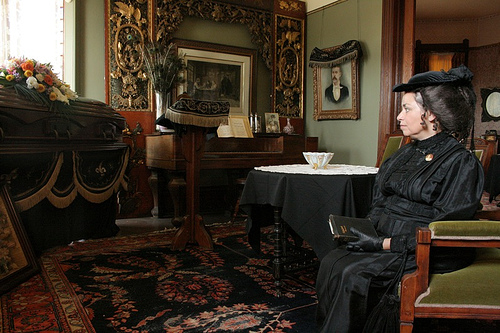
A Quiet Moment at Heritage Square: Los Angeles 2009
Last weekend I took a few hours to go back in time and see up close and personal an era where death and the hereafter had an integrity and tradition that barely exists in my celebrity drenched neighborhood of Hollywood. I left behind the moral nihilism of Los Angeles for a beautiful afternoon of walking through the fall leaves on a time-warped cul-de-sac that has been relocated and restored from the crowded vistas of downtown and moved onto a few square blocks of peace and reverence. It was a grand Halloween muse that managed to steer far clear of the manipulative world of Universal Studio monsters and crass commercialization. Entering the mansions At Heritage Square offered precious moments to view a time when death was celebrated with somber dignity with displays of velvet shrouds, sheaves of wheat, black bordered visiting cards and jewelry made with human hair. The Victorian funeral was in full bloom.
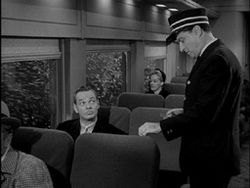
James Daly in "A Stop at Willoughby"
Was the Victorian era a time of bizarre superstitions and strange religious beliefs? Absolutely. But I’m not sure I wouldn’t trade in my tired skateboard tee shirts for a black frock coat any day if I thought I could stay in the quiet comfort of that era for more than one afternoon. Heritage Square’s once a year “Mourning Tour” gives the weary Angeleno a chance to peel back the smog and industrial haze that usually permeates the city and enter into a world of penny-farthing high wheel bicycles and derby hats. I felt like; “Gart Williams, a man protected by a suit of armor all held together by one bolt” in the classic Twilight Zone episode, “A Stop at Willoughby.” Rod Serling certainly understood a “”peaceful, restful place, where a man can slow down to a walk and live his life full measure.” I needed that stop at Willoughby. It is at times like these that I think I was born in the totally wrong century.
 Such places stand a good chance of feeling decidedly “haunted.” Especially on Halloween evenings when shadows lengthen, the light fades early and the wind kicks up dust devils of fall leaves. After all, what is “haunted” anyway? Is it a feeling? Is it an emotion? Is it a vision? Maybe it is a combination of all these things that creates a mood of melencholy and longing for something distant inside of us that we can’t see, hear or touch.
Such places stand a good chance of feeling decidedly “haunted.” Especially on Halloween evenings when shadows lengthen, the light fades early and the wind kicks up dust devils of fall leaves. After all, what is “haunted” anyway? Is it a feeling? Is it an emotion? Is it a vision? Maybe it is a combination of all these things that creates a mood of melencholy and longing for something distant inside of us that we can’t see, hear or touch.
Heritage Square’s unique bygone cityscape isn’t haunted by Sylvia Browne style spooks, con artist mediums and faked-up “real” paranormal scenarios like in the latest movie creepfest, “Paranormal Activity.” No way. Heritage Square captures a need for past simplicity and nostalgia. The perspective on life you feel when you walk through the stone gate still fits our time like a comfortable silk glove and top hat. Plus, the somber etiquette of a Victorian funeral reconstruction expresses a rare chance to see where the line between superstition and culrtural customs intersect.
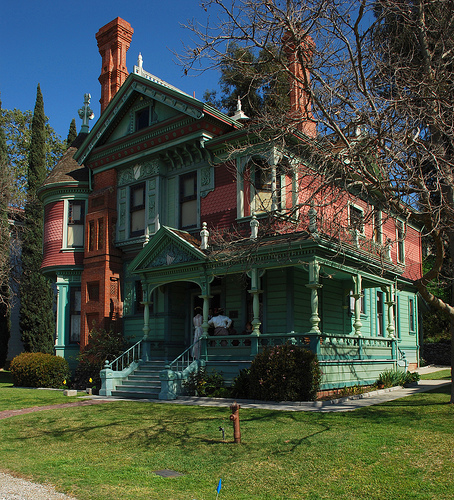
The Perry Mansion
Inside Perry Mansion, the main living room was decked out for the funeral of Judge Stephen Hubble. The servents had their own special mourning room and their own rules to follow. In a home like the Perry’s that was usually far away from a hospital or mortuary, funerals were held right in the parlor. Portraits and anything that would be normally a happy sight in the home were draped in heavy velvet and brocade. This is my kind of joint. It was bad luck to take the coffin out of the house through the front door, so a special indentation was built under Victorian staircases to allow coffins to be turned on end and taken out the back door through the kitchen. Was this really bad luck or just a matter of bad taste? Imagine seeing your neighbor come sliding out his front door on a quiet evening. It just wasn’t done.
As a reminder, a clock was stopped at the dear departed’s time of death and ensconced in the the living room as people came and went from where the corpse was lying in state. Periods of mourning were strictly adhered to with the most stringent timetables. It was taken for granted that families were expected to stay within the confines of these matters of etiquette that had little or nothing to do with relgious backgrounds or national origin. Wearing black was mandatory.
 During these stressful situations local mediums, fortune tellers and Ouiga Board parties were held to contact the spirits. Spiritualism was in its heyday and had not yet been scientifically challenged. Conversing with spirits or having a gypsy sit in for a session was a novelty and was considered part of the customary festivities. Back before it became a serious buisness, the occasional seance or sitting provided “light entertainment” for the high society folks who had the time and money to spend on what was then “all the rage.” The modern equivelent would be a DJ.
During these stressful situations local mediums, fortune tellers and Ouiga Board parties were held to contact the spirits. Spiritualism was in its heyday and had not yet been scientifically challenged. Conversing with spirits or having a gypsy sit in for a session was a novelty and was considered part of the customary festivities. Back before it became a serious buisness, the occasional seance or sitting provided “light entertainment” for the high society folks who had the time and money to spend on what was then “all the rage.” The modern equivelent would be a DJ.
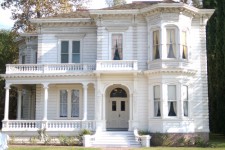
The Hale House
On this day inside the Hale House parlor, Madame Ventroza was on hand to add that special touch of palm or tarot card readings. In the dark wood paneled and book-lined living room, she looked resplendent in her shawls and beads. The line to talk with her was long and anxious. I felt immediately at home. Additionally, visitors were invited to learn about the art of jewelry making with hair; momento mori, as well as talk with two gentlemen in period costume demonstrating spirit photography to the curious. Down the block inside the Shaw House, the prevailing culture of Los Angeles was on display with a Dia De Los Muertos , or Day of the Dead celebration.

The Ford House
Across the street my favorite among The Painted Ladies; The Ford House, stood silent and locked up. Not as ostentatious or grand as the other homes, it still evoked a strong sense of history. Peering through the dusty window panes showed just how haunted a place like this can be. Long pieces of peeling Victorian wallpapar and a crumbling staircase paid solemn testimony to an era when homes were much smaller than today’s sprawling tract homes, but had so much more character even when in shambles. It remains un-restored and looked ominously like Norman Bates’ mother could come rushing up from the basement at any moment. In fact, the real model for the Universal “Psycho House” in Hitchcock’s “Psycho” (1960) once stood here in Heritage Square after it was rescued from its previous roost on Bunker Hill in downtown Los Angeles. To add more mystery to that story, it burned down soon after it was moved to Heritage Square.
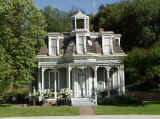
The Shaw House
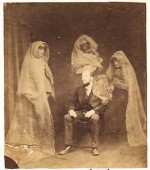
A "Spirit Photograph"
The 1850’s may have been a simpler time, but there was no shortage of woo for the rich and well-to-do. It’s the same today, except that mediums have to wait their own period of mourning before they descend on the bereaved. I wouldn’t call it mourning though. More like waiting just enough time to wait for the obituary to hit the papers or the corpse to cool down.
We have no respect for our dead these days. Once we die, unless we pre-planned a funeral far in advance to spare our children all the grief and hassle, we are likely to find ourselves cremated as the quickest and cheapest way to dispose of the body- and the bothersome distraction on everyone’s valuable time. Spending too much time or cash fretting over a loved one these days could take away from a tennis lesson or gym time. I’m not saying this is always the case and don’t mean to sound too cynical here. We still go to wakes and funeral parties to honor our dead. But it’s not like back in the 1850’s.

Jacko's Last Ride
Of course there are exceptions. We have only to look at Michael Jackson’s lavish funeral to see that when there is big money involved, money gets spent – and made. Paris Hilton weeped, Macauley, Liz Taylor, Chris Tucker and Corey Feldman – they all mourned in their own way. Gladys Knight performed the hymn “Our Father” (The Lord’s Prayer) and moved many to tears. Classy huh? Michael’s entombment ended months of speculation that the singer’s body would be buried at Neverland Ranch, in part to make the property a Graceland-style attraction.
Manners and the superstitions that grow out of earlier customs may change and become streamlined with time, but I miss the old school ways. The Victorians took the time to feel a depth of bereavement and grief that might seem timid by comparison to today’s extravaganzas and excess, but it got the job done with class and integrity. In light of today’s media crush of reporters and film crews kept behind barricades, such customs may seem silly and quaint. I don’t feel that way. To my way of thinking, that’s the difference between a level of security and secrecy about the location of Jackson’s vault guaranteeing it will be turned into a shrine or tourist stop and just sitting in the shade of a quiet picnic on the lawn. I’ll take the picnic. Happy Halloween.


Very Awesome article Mark! Sorry I mean Wholesome Article!
Great reading this on Halloween Night. Wonder if Heritage Square does a big to-do for Christmas if so I am just going to have to visit LA for it. I am really sorry I missed this funeral event…
What beautiful homes, so glad that LA did the right thing and preserved these homes. Sometimes government works correctly…
Just found their website
http://www.heritagesquare.org/
I think folks are far too busy these days for all the ceremony. I remember walking from the house to the church with the local brass band then from the church to the cemetery. You had to have a fair bit of money to have a parlor though; most folks used to be placed in a special part of the church if they didn’t have a parlor. As the population grew it became impractical to use the church for anything other than the funeral mass – imagine walking into a church to find a dozen or so coffins taking up the space (I have seen that sort of thing too, following some tragedy such as a fire) so funeral parlors took over much of the services which used to be provided by churches. It’s a part of history which I lived to see, but the world changes. Dead folks don’t care how they’re treated though; the whole show is for the living.
Nice look back in time… And the last line of your article says it all.
Aye, antiquity holds a great many things that are lost in a driven by profit/status society.
Nicely done, I concur. Which reminds me, why do I ever come back after going home to see family? I think I need a shrink, or maybe a chiropractor?
I loved the article. I too find myself fascinated by the traditions and viewed-from-afar beauty of the Victorian era. I would never want to give up the technology and freedoms we have today, but I try to add a sprinkle of old-timey elegance to my california-casual lifestyle.